DCS AH-64D Apache: ASE - Aircraft Survivability Equipment
Chapter of DCS AH-64D Apache handbook dedicated to ASE - Aircraft Survivability Equpiment. Describes threat detection systems and tells how to use chaff and flares against fired missiles and how to program countermeasure systems.
Last update:
This part of the DCS: AH-64D Apache simulator guide presents the countermeasures systems of the helicopter's ASE - Aircraft Survivability Equipment. We explain how to program chaff and flares and how to use them against enemy missiles. We also show how detected threats can be displayed on the TSD and ASE screens.
- ASE - Aircraft Survivability Equipment
- Required keybinds
- ASE - Using chaff against radar guided missiles
- Programming the chaff dispenser
- CMWS system - Using flares against infrared guided missiles
- Programming the flare dispenser
- CMWS system in CPG's seat
ASE - Aircraft Survivability Equipment
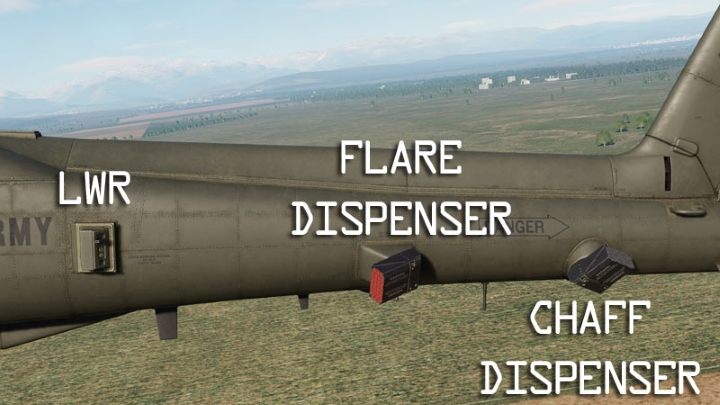
ASE - Aircraft Survivability Equipment contains passive and active defense systems to ensure aircraft's survivability on the battlefield. They can also help avoiding obstacles during low level flights. The main systems are:
- RWR Antenna (Radar Warning Reciever) - antennas that detect tracking by enemy radar;
- Chaff Dispenser - launches countermeasures against radar guided missiles;
- CMWS Detector (Common Missile Warning System) - sensors that detect infrared guided missiles;
- Flare Dispenser - launches countermeasures against infrared guided missiles;
- LWR (Laser Warning Reciever) - sensor that detect illumination by enemy laser beam (not available in the current DCS version);
- Radar Jammer - electronic countermeasure that interferes in operation of enemy radar (not available in the current DCS version);
- WSPS Cutters (Wire Strike Protection System) - special blades on the fuselage designed to cut wires or cables which a helicopter may fly into.
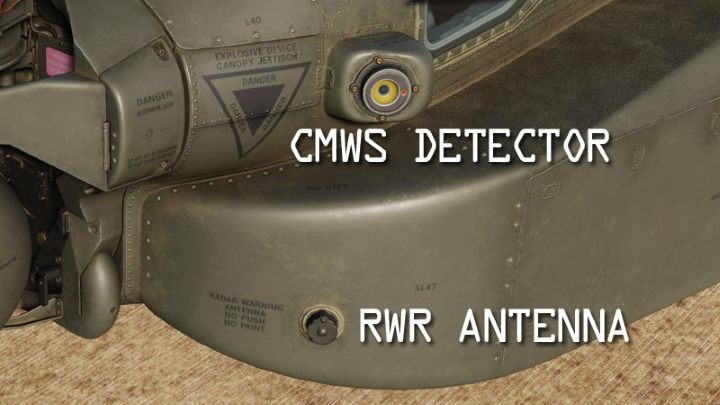
The chaff dispenser can be programmed on the screen in the helicopter at any time. The flare dispenser can only be programmed in the mission editor or on the ground, with engines turned off. If you want to fire a flare manually, use "bypass" mode. The MANUAL mode for chaff dispenser fires only one pack of chaff, instead of the programmed salvo. The ASE screen shows the azimuth to a detected threat. It does not show the distance.
NOTE - The chaff dispenser does not have an automatic mode. It always requires the pilot to fire chaff manually.
The missile detection system does not distinguish friendly missiles from enemy missiles. You may see "missile launch" warnings even when friendly Hellfire is launched.
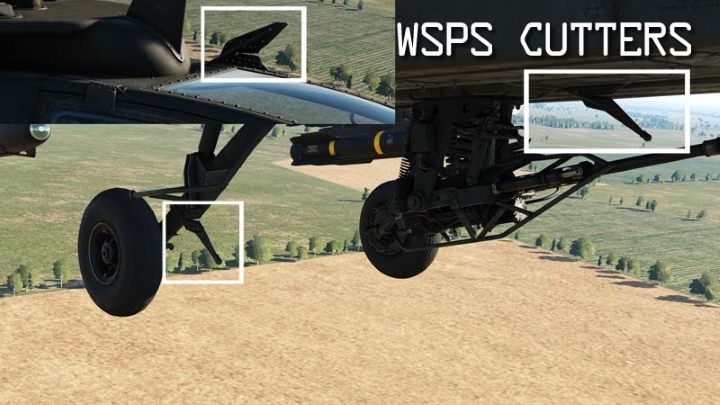
Required keybinds
- Chaff Dispense - fires chaff;
- Flare Dispense -fires flare;
- George AI Interface - displays the George AI interface AI control buttons;
- Kneeboard - displays the Kneeboard to change the flare program (RShift + K)
ASE - Using chaff against radar guided missiles
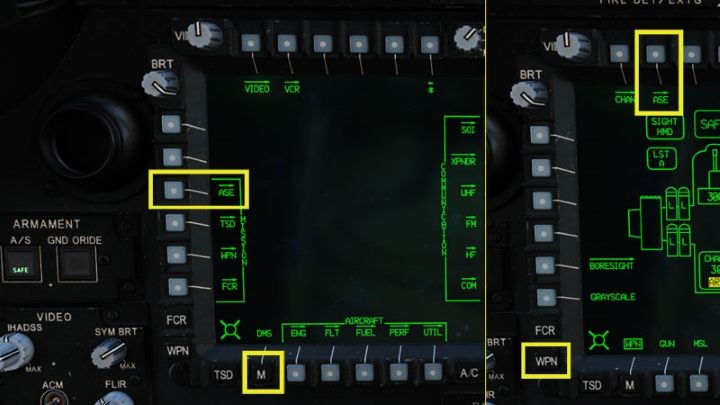
Select the shortcut to the M main menu or the WPN - weapon screen. Click the ASE button.
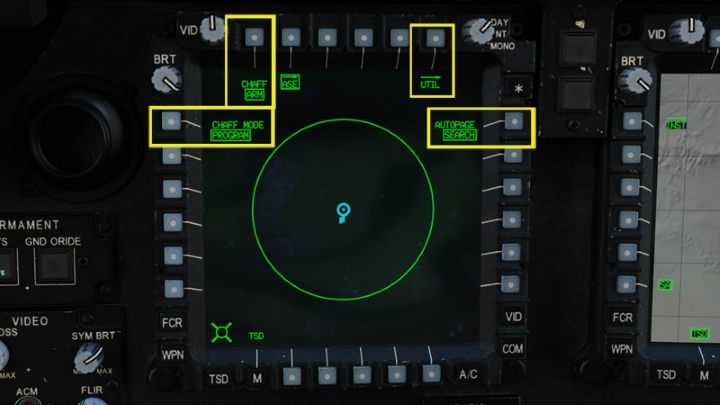
The ASE screen shows the helicopter symbol "ownship" in the center of the top view. The available options on the screen are:
- Chaff: ARM / SAFE - arms or secures the chaff dispenser;
- Chaff Mode PROGRAM / MANUAL - switches between a manual mode with one set of chaff and programmed salvo;
- UTIL - chaff dispenser settings;
- Autopage :displays detected threats on the TSD map screen if the ASE screen isn't on. if the ASE screen is not enabled on any monitor: - SEARCH - displays threats when a search radar is detected - ACQUISITION - displays a threat when enemy radar is tracking the helicopter - TRACK - displays a threat when enemy radar locked the helicopter - OFF - disables any threats on the TSD map screen.

UTIL options:
- RLWR (Radar Laser Warning Reciever) - enables / disables warnings against enemy radar or laser tracking;
- RLWR Voice: NORM / TERSE - voice message alerts: Normal / Terse.
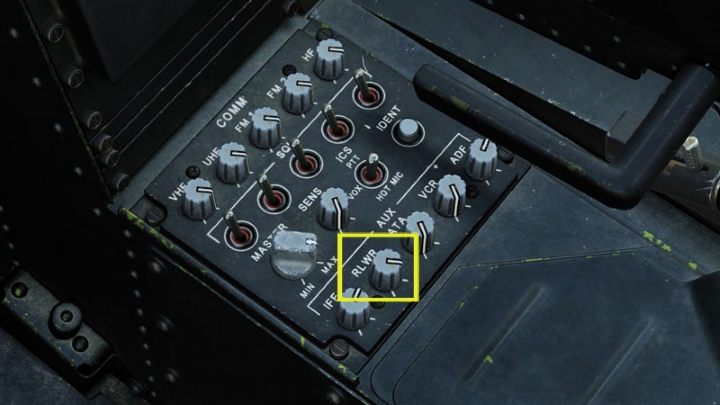
Make sure the RLWR knob on the radio panel is not muted so that you can hear the voice alerts of the RLWR system.
Programming the chaff dispenser
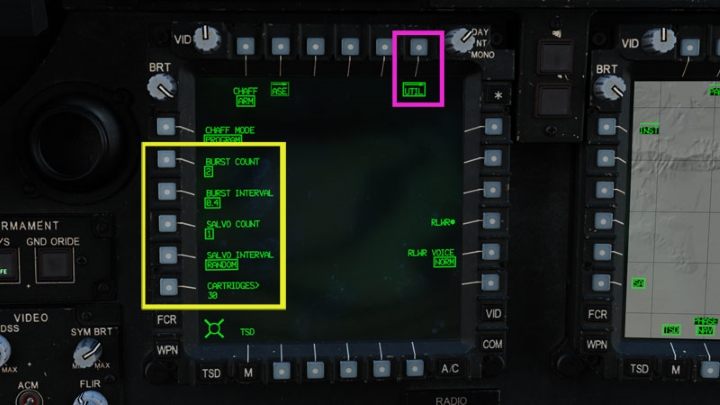
Press UTIL button. You will see options to set the desired number of chaff and interval between them when launching a program.
- BURST COUNT (1,2,3,4,6,8) - sets the number of chaff in one salvo;
- BURST INTERVAL (0.4, 0.3, 0.2, 0.1) - sets the time interval between chaff in one salvo;
- SALVO COUNT (1, 2, 4, 8, CONTINUOUS) - sets the number of salvos (continuous fires chaff salvos until the Chaff Dispenser button is pressed again);
- SALVO INTERVAL (1,2,3,4, 5, 8, RANDOM) - time interval in seconds between salvos ("Random" is a fixed sequence of 3,5, 2 and 4 seconds);
- CARTRIDGES (0-30) - allows you to manually enter the chaff amount loaded into the helicopter (there is no need to change anything here).
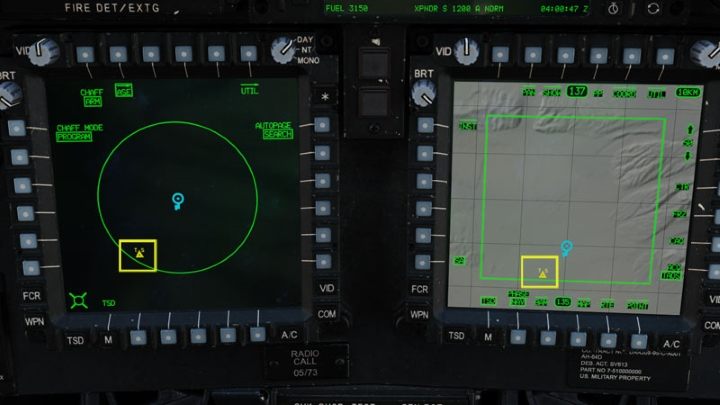
Any detected threat is displayed on the ASE screen as a yellow triangle relative to the aircraft's heading. It does not show the range. The numbers and letters around it indicate the type of threat. Threats can be duplicated on the TSD screen. A new threat has a larger symbol for a brief moment.
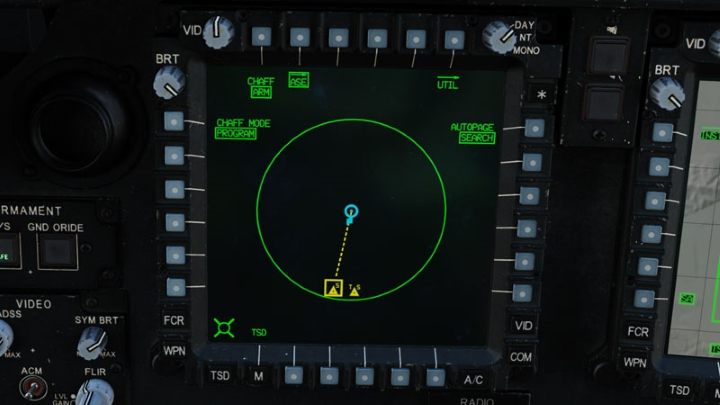
If an enemy radar locks our helicopter, a dashed line connecting ownship icon with the outlined threat symbol will appear. When an enemy missile is fired, the threat symbols will start flashing.
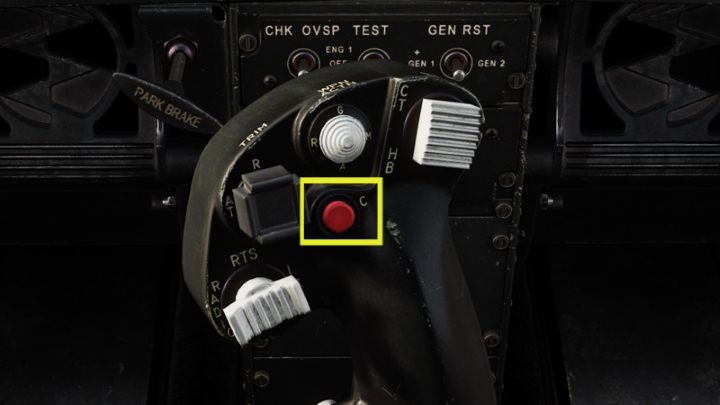
If a missile is launched, press the chaff dispenser button while taking evasive maneuvers. There is no auto mode for chaff dispenser, so every time you need to decide when to press the button.
CMWS system - Using flares against infrared guided missiles
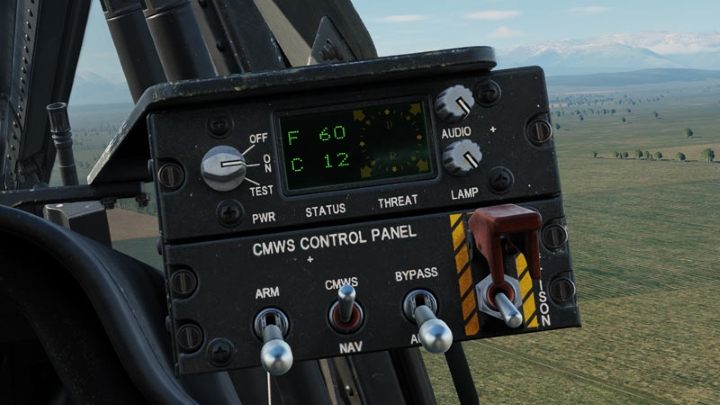
The CMWS infrared guided missile warning system is not an integral part of the Apache. You can't control it on the MFD screens. CMWS Control Panel is a separate box installed only in the pilot's cockpit. CMWS controls:
- PWR ON / OFF / TEST - turns the system on/off or runs the built-in test;
- AUDIO - adjusts volume of the voice alerts;
- LAMP - adjusts display brightness;
- ARM / SAFE - arms the system
- CMWS / NAV - switches the active mode: missile detection (CMWS) or radio navigation (NAV)
- BYPASS / AUTO - toggles automatic mode (Auto) or manual (Bypass). The Bypass mode - launching one flare only - also works when AUTO mode is active.
- JETTISON - emergency jettison of all flares onboard.
NOTE - when AUTO mode is active, the system may react when allied Hellfires are launched, wasting flares unnecessarily.

The CMWS display:
- F 53 - the number of flares remaining;
- C 30 - the number of chaff remaining;
- D - Dispense - flares or chaff are being launched when lit;
- R - Ready - flares and chaff are ready to use when lit;
- Arrows - show a direction to a detected threat.
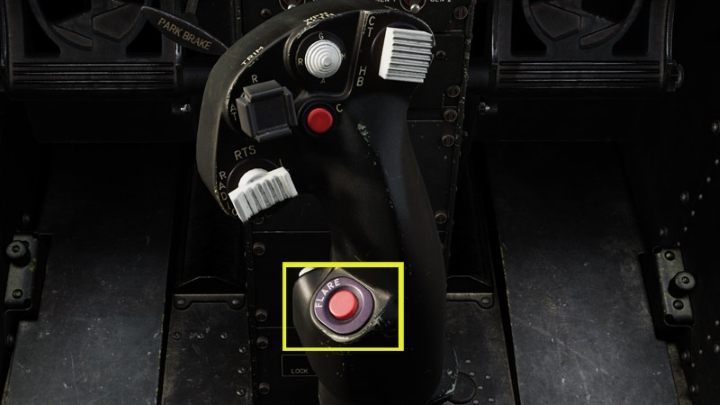
Press the flare dispenser button to launch flares when you hear the "missile launched" alert and see a white smoke trail coming from the ground. You may also rely on AUTO mode, but it may run out of flares in no time.
Programming the flare dispenser
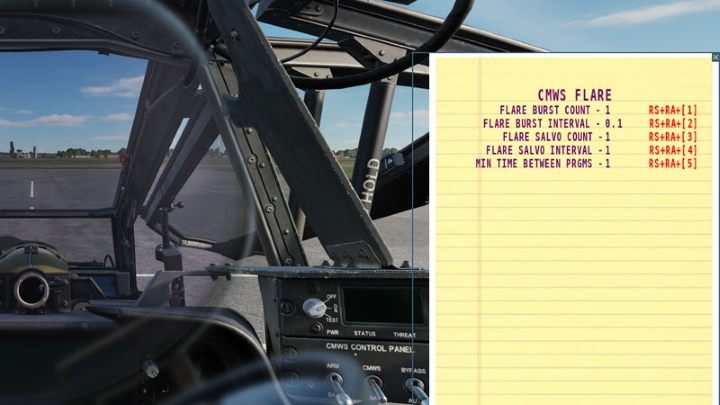
The flare dispenser programs can be set in the mission editor or on the ground with the engines turned off using the kneeboard. Just press RShift + K. The available options are the same as for the chaff dispenser:
- FLARE BURST COUNT (1,2,3,4,6,8) - sets the number of flares in one salvo;
- FLARE BURST INTERVAL (0.4, 0.3, 0.2, 0.1) - sets the time interval between flares in one salvo;
- FLARE SALVO COUNT (1, 2, 4, 8, CONTINUOUS) - sets the number of salvos (continuous fires flare salvos until the Flare Dispenser button is pressed again);
- FLARE SALVO INTERVAL (1,2,3,4, 5, 8, RANDOM) - time interval in seconds between salvos (Random is a fixed sequence of 3,5, 2 and 4 seconds);
- MIN TIME BETWEEN PRGMS (1,2,3,4) - timeout in seconds between restarting the program.
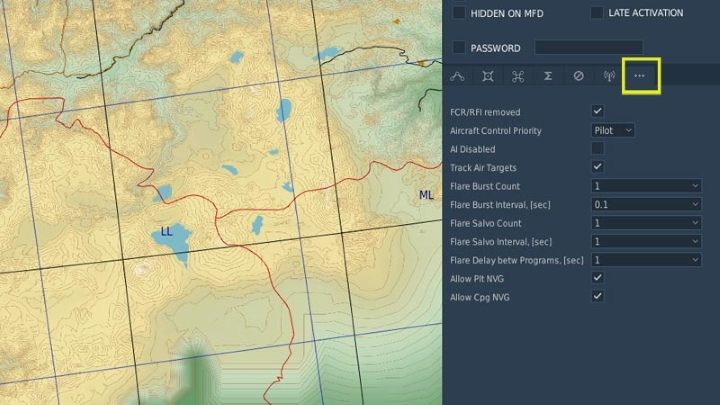
The flare settings in the mission mission works the same.
CMWS system in CPG's seat
When flying as a copilot / gunner, you don't have access to a CMWS control panel. However, you can use George AI Helper by pressing LCtrl + V keys, then press George AI Interface LEFT SHORT until the CMWS mode is displayed. The available options are:
- George Interface UP SHORT - switches the system ARM / SAFE
- George Interface DOWN SHORT - selects AUTO / BYPASS mode.
- DCS AH-64 Apache Guide
- DCS AH-64D Apache: Game guide
- DCS AH-64D Apache: Systems and Sensors
- DCS AH-64D Apache: Sight Source and Acquisition Source
- DCS AH-64D Apache: TADS - Target Acquisition and Designation Sight
- DCS AH-64D Apache: PNVS - Pilot Night Vision System - how to use night vision?
- DCS AH-64D Apache: TSD - Tactical Situation Display
- DCS AH-64D Apache: ASE - Aircraft Survivability Equipment
- DCS AH-64D Apache: Radio Communication - how to use radios?
- DCS AH-64D Apache: Systems and Sensors
- DCS AH-64D Apache: Game guide
You are not permitted to copy any image, text or info from this page. This site is not associated with and/or endorsed by the developers and the publishers. All logos and images are copyrighted by their respective owners.
Copyright © 2000 - 2025 Webedia Polska SA for gamepressure.com, unofficial game guides, walkthroughs, secrets, game tips, maps & strategies for top games.
